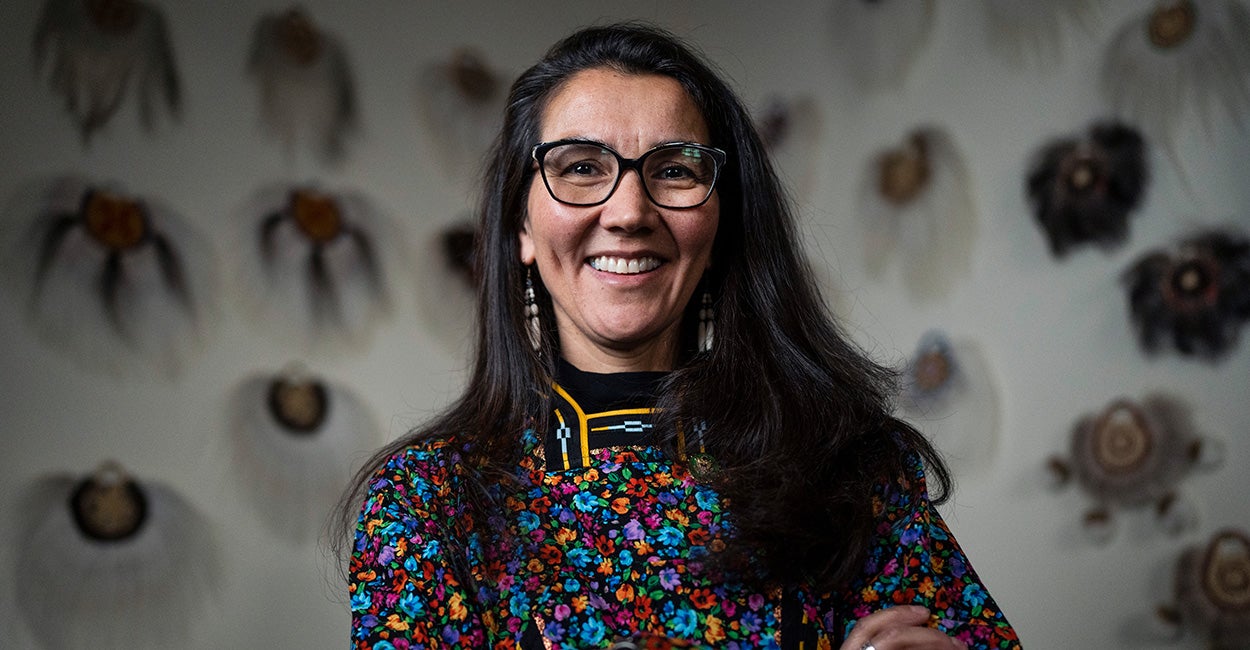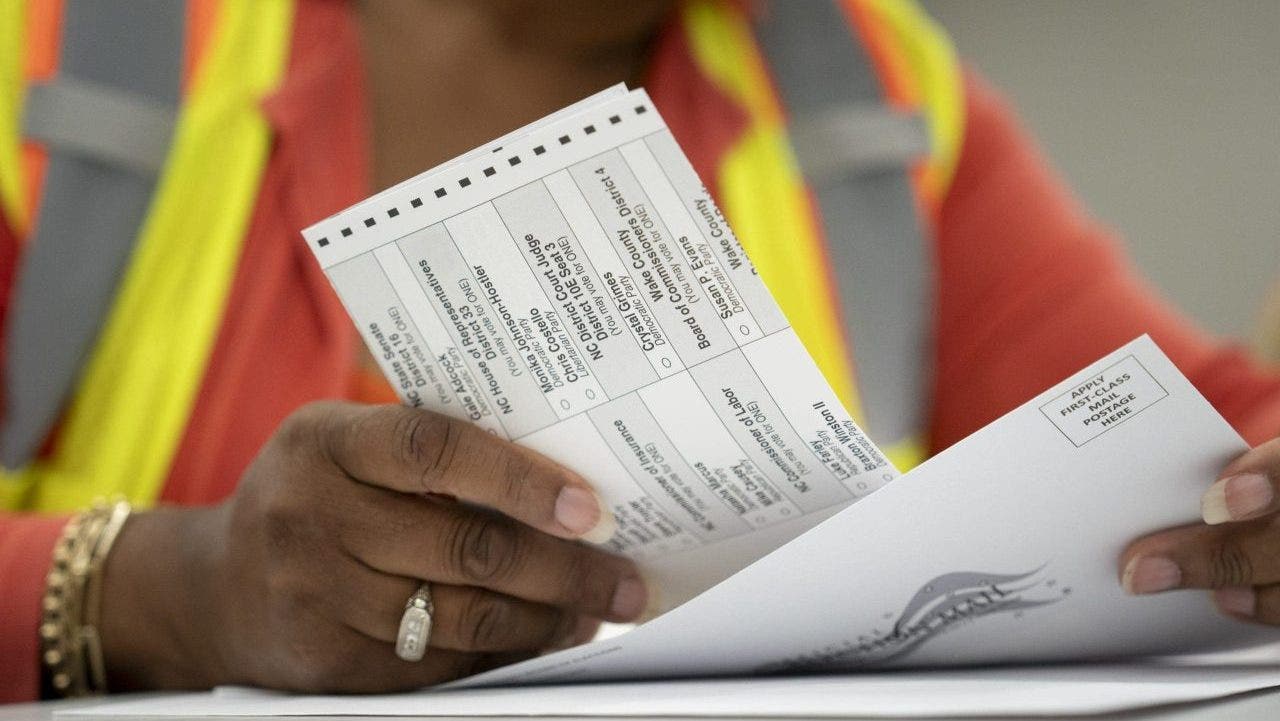MERTARVIK — Growing up along the banks of the Ninglick River in Southwest Alaska, Ashley Tom would look out of her window after strong storms from the Bering Sea hit her village and notice something unsettling: the riverbank was creeping ever closer.
It was in that home, in the village of Newtok, where Tom’s great-grandmother had taught her to sew and crochet on the sofa, skills she used at school when students crafted headdresses, mittens and baby booties using seal or otter fur. It’s also where her grandmother taught her the intricate art of grass basket weaving and how to speak the Yupik language.
Today, erosion and melting permafrost have just about destroyed Newtok, eating about 70 feet of land every year. All that’s left are some dilapidated and largely abandoned gray homes scraped bare of paint by salt darting in on the winds of storms.
“Living with my great-grandmother was all I could remember from Newtok, and it was one of the first houses to be demolished,” said Tom.
:quality(70)/cloudfront-us-east-1.images.arcpublishing.com/adn/RGYBAXQVCLZVAJNBQHC2S26AH4.jpg)
In the next few weeks, the last 71 residents will load their possessions onto boats to move to Mertarvik, rejoining 230 residents who began moving away in 2019. They will become one of the first Alaska Native villages to complete a large-scale relocation because of climate change.
Newtok village leaders began searching for a new townsite more than two decades ago, ultimately swapping land with the federal government for a place 9 miles away on the stable volcanic underpinnings of Nelson Island in the Bering Strait.
But the move has been slow, leaving Newtok a split village. Even after most residents shifted to Mertarvik, the grocery store and school remained in Newtok, leaving some teachers and students separated from their families for the school year.
:quality(70)/cloudfront-us-east-1.images.arcpublishing.com/adn/3TY7DABTNZRZCZMWBADLY2QNKQ.jpg)
Calvin Tom, the tribal administrator and Ashley’s uncle, called Newtok “not a place to live anymore.” Erosion has tilted power poles precariously, and a single good storm this fall will knock out power for good, he said.
For now, the rush is on to get 18 temporary homes that arrived in Mertarvik on a barge set up before winter sets in.
Alaska is warming two to three times faster than the global average. Some villages dotting the usually frigid North Slope, Alaska’s prodigious oil field, had their warmest temperatures on record in August, prompting some of Ashley Tom’s friends living there to don bikinis and head to Arctic Ocean beaches.
It’s the same story across the Arctic, with permafrost degradation damaging roads, railroad tracks, pipes and buildings for 4 million people across the top of the world, according to the Washington, D.C.-based Arctic Institute. In the Russian Arctic, Indigenous people are being moved to cities instead of having their eroding villages relocated and across Scandinavia, reindeer herders are finding the land constantly shifting and new bodies of water appearing, the institute said.
:quality(70)/cloudfront-us-east-1.images.arcpublishing.com/adn/MA22M3YPSBMZ4EKFW24A2PSLYQ.jpg)
About 85% of Alaska’s land lies atop permafrost, so named because it’s supposed to be permanently frozen ground. It holds a lot of water, and when it thaws or when warmer coastal water hits it, its melting causes further erosion. Another issue with warming: less sea ice to act as natural barriers that protect coastal communities from the dangerous waves of ocean storms.
The Yupik have a word for the catastrophic threats of erosion, flooding and thawing permafrost: “usteq,” which means “surface caves in.” The changes are usually slow — until all of a sudden they aren’t, as when a riverbank sloughs off or a huge hole opens up, said Rick Thoman, a climate specialist with the International Arctic Research Center at the University of Alaska Fairbanks.
There are 114 Alaska Native communities that face some degree of infrastructure damage from erosion, flooding or permafrost melt, according to a report in January from the Alaska Native Tribal Health Consortium. Six of them — Kivalina, Koyukuk, Newtok, Shaktoolik, Shishmaref and Unalakleet — were deemed imminently threatened in a Government Accountability Office report more than two decades ago.
:quality(70)/cloudfront-us-east-1.images.arcpublishing.com/adn/JXD5CI6NPFCNQJQK3ZJVN53PLA.jpg)
Communities have three options based on the severity of their situations: Securing protection to stay where they are; staging a managed retreat, moving back from erosion threats; or a complete relocation.
Moving is hard, starting with finding a place to go. Communities typically need to swap with the federal government, which owns about 60% of Alaska’s land. But Congress has to approve swaps, and that’s only after negotiations that can drag on: Newtok, for example, began pursuing the Nelson Island land in 1996 and didn’t wrap up until late 2003.
:quality(70)/cloudfront-us-east-1.images.arcpublishing.com/adn/SUL2UDLJZ5EXLHPX6KMW3G6OYI.jpg)
“That’s way too long,” said Jackie Qatalina Schaeffer, the director of planning initiatives at the Alaska Native Travel Health Consortium.
“If we look back a decade at what’s happened as far as climate change in Alaska, we’re out of time,” she said. “We need to find a better way to help communities secure land for relocation.”
Kivalina last year completed a master plan for relocation and is negotiating with an Alaska Native regional corporation for the land, a process that could take three to five years, Schaeffer said.
Another big hurdle is cost. Newtok has spent decades and about $160 million in today’s dollars on its move. Estimates to relocate Kivalina vary from $100 million to $400 million and rising, and there’s currently no federal funding for relocation. The Federal Emergency Management Agency has disaster funding and programs, Schaeffer said, but that comes only after a disaster declaration.
:quality(70)/cloudfront-us-east-1.images.arcpublishing.com/adn/CIVJARFDNIRZAL3AXHDKRRVS7E.jpg)
:quality(70)/cloudfront-us-east-1.images.arcpublishing.com/adn/DUIIJ6PBECMBDA2UPUO5E4AIDE.jpg)
In 2018, a resource for Alaska communities identified 60 federal funding sources for relocation, but according to the Unmet Needs report, only a few have been successfully used to address environmental threats. But an infusion of funding into these existing programs by the Bipartisan Infrastructure Law and the Inflation Reduction Act could provide benefits to threatened Alaska communities, the report said.
About $4.3 billion in 2020 dollars will be needed to mitigate infrastructure damage over the next 50 years, the health consortium report says. It called for Congress to close an $80 million annual gap by providing a single committed source to assist communities.
“Alaska Native economic, social, and cultural ways of being, which have served so well for millennia, are now under extreme threat due to accelerated environmental change,” the report said. “In jeopardy are not just buildings, but the sustainability of entire communities and cultures.”
After five years of separation and split lives, the residents of Newtok and Mertarvik will be one again. The school in Newtok closed and classes started in August for the first time in a temporary location in Mertarvik. A new school building should be ready in 2026. The Newtok grocery recently moved to Mertarvik, and there’s plans for a second grocery and a church, Calvin Tom said.
The new village site has huge benefits, including better health, Tom said. For now, most of the people of Mertarvik are still using a “honey bucket” system rather than toilets. But that method of manually dumping plastic buckets of waste should be replaced by piped water and sewer within the next few years. The new homes in Mertarvik are also free of black mold that crept into some Newtok homes on moisture brought by the remnants of Typhoon Merbok two years ago.
Tom said there’s talk of someday renaming the relocated town Newtok. Whatever the name, the relocation offers assurance that culture and traditions from the old place will continue. An Indigenous drum and dance group is practicing at the temporary school, and subsistence hunting opportunities — moose, musk ox, black bear, brown bear — abound.
:quality(70)/cloudfront-us-east-1.images.arcpublishing.com/adn/BLC6MNO6HUWNDMYPRELPNBR4HE.jpg)
:quality(70)/cloudfront-us-east-1.images.arcpublishing.com/adn/PCNFPRF3YDUSZXPVCFKNNU3LIU.jpg)
A pod of belugas that comes by every fall should arrive soon, and that hunt will help residents fill their freezers for the harsh winter ahead.
Ashley Tom is excited by the arrival of the last Newtok residents in Mertarvik. Although their home will be different from what they’ve known for most of their lives, she’s confident they will come to appreciate it as she has.
“I really love this this new area, and I just feel whole here,” she said.
___
Thiessen reported from Anchorage.

/cloudfront-us-east-1.images.arcpublishing.com/gray/3CJGZDBLEZD4PCJB3ZNK64ARIA.jpg)







:quality(70)/cloudfront-us-east-1.images.arcpublishing.com/adn/3TY7DABTNZRZCZMWBADLY2QNKQ.jpg)

/cdn.vox-cdn.com/uploads/chorus_asset/file/24774109/STK156_Instagram_threads_2.jpg)


















